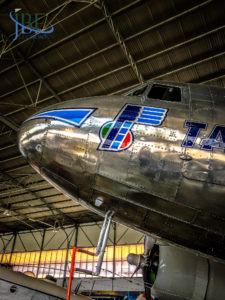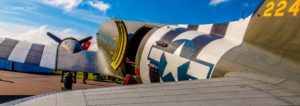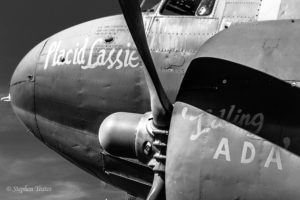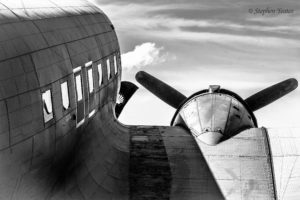Julie Boatman Filucci's Blog, page 8
July 18, 2018
Museu do Ar: A Dakota For Portugal
A palpable sense of honor hangs in the air of the voluminous display hangar at the Sintra Air Base in Portugal. Just north of Lisbon, the air base hosts the nation’s air force training academy, as well as its flagship museum, the Museu do Ar (Museum of the Air, in Portuguese).
Within the main hangar and its neighbors, hundreds of noteworthy, historic, and inspiring aircraft stand waiting to help inform the curious—and the young—of the history of aviation in Portugal, and its influence on the world. Though those outside Portugal often equate its exploratory prowess with its efforts on the seas, its forays into the air—and the annals of history—began in the early days of aviation itself, and grew to prominence in the golden age of aviation, before World War II, and post-war, as Portugal used airplanes to tie together its former colonies in Africa.
You may not know, for example, that the Portuguese were among the first to cross the Atlantic—years before Lindbergh’s solo flight—as they sought passage to Brazil from Europe. In fact, the aviators Gago Coutinho and Sacadura Cabral made the first crossing of the South Atlantic in 1922, flying in segments from Lisbon to Rio de Janeiro using three different Fairey III biplanes.
But among the museum’s proudest airplanes, looking over all of its fleet, my pick must be the Douglas C-47A Dakota. She forms the center of an exhibit that not only tells the airframe’s story, but also the story of TAP, the airline of Portugal, and those that flew her.
When a group of volunteers looked around for a Douglas DC-3 or its equivalent military model to restore in honor of TAP’s 70th anniversary in March 2015, they couldn’t find an example that had actually flown for the airline. All had been withdrawn from use or otherwise lost. Instead, the group found the C-47A used by the DGA (Direcção Geral de Aviação), the former authority governing aviation in Portugal. Its Douglas construction number, 19503, last carried the registration CS-DGA.
To reflect the dual purpose that the airplane would have in the museum, the group decided to give her two faces: one, the airmarkings of the DGA to suit her original mission, and the other, the classic TAP livery, to glorify the history of the airline. On the TAP side of her tail, she carries the registration CS-TDE to signify “Transporte” “Dakota” and “E,” the fifth letter of the alphabet, as she was refurbished to resemble the fifth airplane in the TAP fleet.
Inside and out, a team led by current TAP captain Carlos Tomaz bestowed great care on her refurbishment. Tomaz would dearly love to return her to flying status, but for now she serves as an educational platform and living part of history central to the museum. Periodically, the group hosts “Dakota Talks” to share stories from her past, and those of the other DC-3s and C-47s operated by Portuguese airlines, military, and governmental agencies.
The Dakota at the Museu do Ar in Sintra, Portugal, displays TAP vintage colors
For more information on the Vintage Aero Club and the Dakota restoration:
http://grupodakotatap.wordpress.com
http://vintageaeroclub.wordpress.com
Google+
June 6, 2018
D-Day Squadron: 2018
Every airplane tells a story, both as you approach it, through its lines, its condition, its patina of paint, as well as in flight, by the weight of the cargo and mission it has borne.
Every airplane that flew during the Normandy Invasion, on D-Day, June 6, 1944, executing any number of the individual missions of the day, carried far more than that. They carried their men inside, whether pilot or maintenance chief, paratrooper or glider crew on a string. On board one of the Douglas C-47s that flew that day, even to this day, you can smell the sweat and the fear and the hope that this long shot would work.
Every airplane tells its own piece of a greater story. So to bring more than three dozen of them together for the 75th anniversary of that fateful day means more than just a sum of the logistics and collaboration, the pride and even vanity of accomplishing yet another transatlantic crossing in a classic warbird. That’s why, come 2019, the gathering will feature everyone’s collective effort, as C-47s such as Placid Lassie, operated by the D-Day Squadron (an arm of the Tunison Foundation based in Georgia), make the once—now twice–in-a-lifetime trip.
Daks Over Normandy staged a gathering of D-Day airplanes at Cherbourg in June 2013 to commemorate 70 years since the invasion. While poignant and well-received, the experience that the person on the ground and outside the airport fence could have with the airplanes and their crew lacked the engagement that the organizers hoped for. Restrictions at the French airfield made it nearly impossible for folks outside the flight crews to visit the airplanes, to see them up close, to smell, touch, and even taste the stories emanating from within.
To solve this missed opportunity, Daks Over Normandy and its partner organizations plan two parts to the 2019 event. The first will bring the North American based aircraft over the pond into Duxford, England, via the northern route, currently planned to depart from the Waterbury-Oxford Airport in Connecticut and fly via Presque Isle, Maine; Goose Bay, Labrador; Bluie One West (now Narsarsuaq airfield, in Greenland); Reykjavik, Iceland; Ireland, and then on into England. While lighter aircraft with less range make the crossing all the time, doing so requires not only a lot of investment ($75,000 to $100,000 per airplane) but also logistics such as staging enough avgas at Narsarsuaq to service the series of C-47s and DC-3s with their large fuel tanks. Even so, the participating airplanes will make the trip in flights of 3 to reduce the load on the single fuel truck stationed there.
The second event recreates the invasion itself, in modern form, with the aircraft departing the south of England for the Normandy coast on the eve of the anniversary itself for fly-bys and parachute drops in France over the following days. While in France this time, the aircraft will base out of Caen, and total 36 in number, including aircraft planning to come in from as far as South Africa.
Placid Lassie may be known to folks as Union Jack Dak, for the UK flag it wore on its fuselage following its initial a few years back. In her wartime livery, she flew in all manner of operations in the European Theater during the war. She’ll be joined by Virginia Ann, a C-47 from California, a veteran of Market Garden as well, and the Liberty Foundation’s C-47 that was used to recover parts from Glacier Girl in Greenland’s ice—among many others.
The founders of the D-Day Squadron plan more events around and following the anniversary commemoration, starting with a formation flight near Manhattan prior to the crossing, and a visit to Berlin to honor those who served post-war in the Berlin Airlift. ”We’ll start in war and finish in peace,” said Eric Zipkin, chief pilot for the group. And, if all goes according to plan, about 10 of the airplanes will fly to Oshkosh 2019 to close the chapter—and continue the D-Day Squadron’s continuing mission of education and outreach. To this end, the D-Day Squadron is recruiting one veteran and one student from each of the 50 states to experience the D-Day flyover in France.
As we remember D-Day today, in 2018, preparations have long been underway for next year’s extravaganza. While the organization actively seeks sponsorship and likely has key players on board by the time you read this, you too can help to support their mission. Visit ddaysquadron.org for more information.
Google+
September 11, 2017
Airlift Uplift
This is the way it should feel. This is the way it *did* feel. And it was good to get that feeling back.
I had plans to go to Wichita last weekend to take care of lingering business in town, and to see some of the warm and wonderful friends that I’ve made there. I also knew that the Citation Special Olympics Airlift (CSOA) [http://www.kake.com/home/headlines/Ka...] would launch that Saturday. I’ve been blessed to be part of the event (in which more than 100 private aircraft owners volunteer their airplanes and crews to fly roughly 700 Special Olympics athletes from around the country to the summer games) in 2006 [http://www.aopa.org/News-and-Video/Al...] and 2010.
The CSOA has held a special place in my heart as one of the best examples of participation-based corporate and philanthropic leadership. Many of the Citation owners involved fly their own aircraft and make it a non-negotiable part of their calendars to spend two Saturdays in June ferrying athletes and their coaches cross country. For corporate owners, the flight departments often take the lead, and crews compete for the opportunity to volunteer.
None of these folks do it for glory or self promotion. They do it because of the feeling.
So when we were planning the weekend’s events, a friend I was staying with mentioned that she had volunteered to be part of the Textron Aviation crowd at the send-off for the Kansas Special Olympics athletes. She then said, “You should come.” I jumped at the chance.
I had not been back inside the Hex at Cessna since leaving the company in January 2012, but it took me back to the first time I was there. The Hex is the nickname for the customer delivery hangar at Cessna’s main corporate office at Mid-Continent Airport (KICT). This is also where the company has traditionally gathered for very special events.
When we arrived, just after 8 am, on the 14th, the athletes were already in the Hex enjoying a light breakfast before departure. In as much stealth as a couple hundred happy folks can muster, we gathered outside the hangar doors on the ramp in front of three CJs. We practiced our cheers, and the way we would “part the seas” for the athletes and coaches as they came out to the airplanes.
Then, the magic moment. The hangar doors lifted [http://instagram.com/p/pWYXxizWLh/] and the athletes saw their “rides” for the first time. For many, it would be their first trip on an airplane. For all of us in the volunteer crowd, who love aviation and know its worth, it was a validation of that worth, and acknowledgment of the effort the athletes had made to arrive at that moment.
That feeling, that you’re part of something bigger, something worth more than a stock price, is what had made me proud to be a Cessnan. It was real joy.
I challenge every aviation company to put that value first. It may just be what saves us.
from June 17, 2014
Google+







